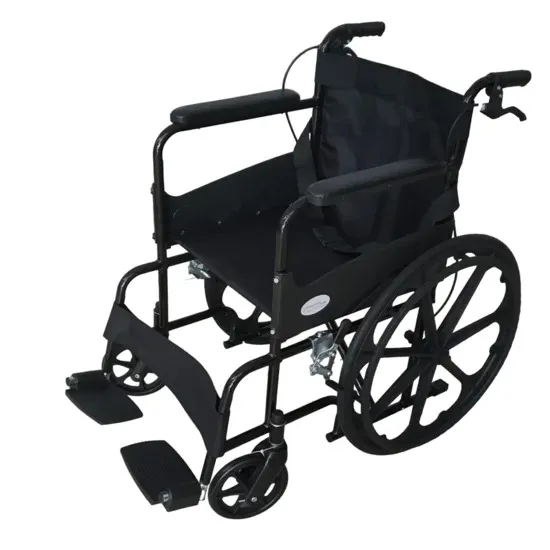Wheelchairs: Empowering Mobility and Independence...!!!
Wheelchairs play a critical role in enhancing mobility, independence, and overall quality of life for individuals with mobility impairments. Whether manual or electric, wheelchairs offer a range of benefits that enable users to participate fully in daily activities, education, employment, and recreation.

Wheelchairs are invaluable devices designed to aid individuals with mobility impairments, granting them the freedom to move independently and significantly improving their quality of life.
Types of Wheelchairs
1. Manual Wheelchairs:
-
Description: Propelled by the user or an attendant, manual wheelchairs come in various designs, including standard, lightweight, and sports models.
-
Uses: Ideal for individuals with sufficient upper body strength to propel themselves or who have assistance. Commonly used for daily activities, sports, and short-distance travel.
2. Electric Wheelchairs:
-
Description: Also known as power wheelchairs, these are battery-operated and controlled using a joystick or other input devices.
-
Uses: Suitable for individuals with limited upper body strength or severe mobility impairments. Used for indoor and outdoor mobility, providing greater independence.
3. Transport Wheelchairs:
-
Description: Lightweight wheelchairs designed for short-term use and easy transportation. They have smaller wheels and are typically propelled by an attendant.
-
Uses: Ideal for temporary use, such as during travel or hospital visits. Easy to fold and store.

4. Standing Wheelchairs:
-
Description: These wheelchairs can shift the user from a seated to a standing position, either manually or electronically.
-
Uses: Beneficial for users who need to change positions frequently. Promote circulation, reduce pressure sores, and enable the user to perform tasks at a higher level.
5. Pediatric Wheelchairs:
-
Description: Specifically designed for children, with adjustable features to accommodate growth.
-
Uses: Used by children with mobility impairments to participate in daily activities, attend school, and engage in play. Support the child’s development and independence.
Uses and Benefits of Wheelchairs
1. Enhanced Mobility:
-
Wheelchairs provide users with the ability to move freely and independently, whether indoors or outdoors. Enable individuals to navigate various environments, including homes, workplaces, and public spaces.
2. Improved Quality of Life:
-
By offering greater independence, wheelchairs contribute to an improved quality of life. Users can engage in social activities, pursue hobbies, and participate in community events, reducing feelings of isolation.
3. Access to Education and Employment:
-
Wheelchairs enable individuals with mobility impairments to access educational institutions and workplaces. This access promotes inclusivity and allows users to achieve their academic and professional goals.
4. Physical Health Benefits:
-
Using a wheelchair can prevent further injury and deterioration of existing conditions. For example, standing wheelchairs promote better circulation and reduce the risk of pressure sores. Properly fitted wheelchairs can also prevent posture-related issues.
5. Participation in Sports and Recreation:
-
Sports wheelchairs are designed for various recreational activities, including basketball, tennis, and racing. These wheelchairs enable users to stay active, improve physical fitness, and enjoy the mental health benefits of sports.
6. Caregiver Assistance:
-
Wheelchairs reduce the physical strain on caregivers by enabling users to move independently or with minimal assistance. This allows caregivers to provide better support and focus on other aspects of care.

Challenges and Considerations
1. Accessibility:
-
Accessibility remains a challenge in many places. Wheelchair users may encounter obstacles such as narrow doorways, lack of ramps, and inadequate public transportation. Advocacy for improved accessibility is essential.
2. Cost:
-
Wheelchairs, especially electric models, can be expensive. Insurance coverage and funding options vary, and financial assistance may be necessary for some users.
3. Maintenance:
-
Regular maintenance is crucial to ensure the longevity and functionality of wheelchairs. Users must be aware of maintenance requirements and have access to repair services.
4. Customization:
-
Wheelchairs should be customized to fit the user’s specific needs and preferences. Factors such as seat width, backrest height, and armrest type are important for comfort and functionality.
Wheelchairs play a critical role in enhancing mobility, independence, and overall quality of life for individuals with mobility impairments. Whether manual or electric, wheelchairs offer a range of benefits that enable users to participate fully in daily activities, education, employment, and recreation. Addressing challenges related to accessibility, cost, and customization is essential to ensure that wheelchair users can enjoy the full benefits of these vital devices.
What's Your Reaction?

















